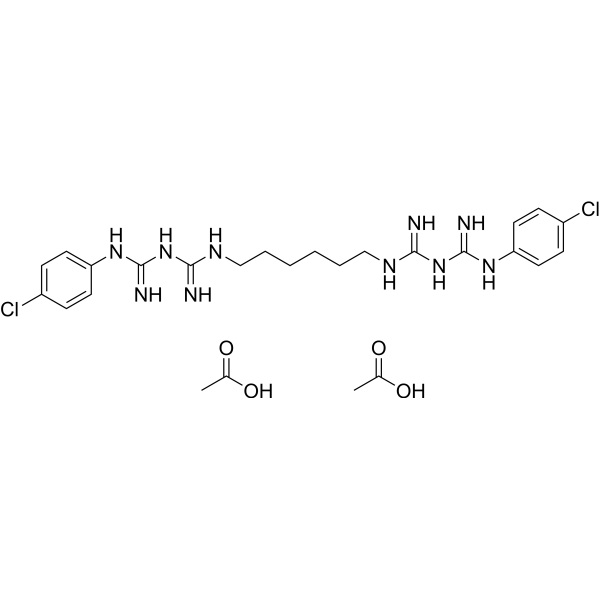Physicochemical Properties
| Molecular Formula | C26H38CL2N10O4 |
| Molecular Weight | 625.55 |
| Exact Mass | 624.245 |
| CAS # | 56-95-1 |
| Related CAS # | Chlorhexidine (digluconate);18472-51-0;Chlorhexidine dihydrochloride;3697-42-5;Chlorhexidine;55-56-1;Chlorhexidine acetate hydrate;206986-79-0 |
| PubChem CID | 9562059 |
| Appearance | Typically exists as solid at room temperature |
| Boiling Point | 699.3ºC at 760mmHg |
| Melting Point | 153-156ºC |
| Flash Point | 376.7ºC |
| LogP | 6.374 |
| Hydrogen Bond Donor Count | 8 |
| Hydrogen Bond Acceptor Count | 6 |
| Rotatable Bond Count | 13 |
| Heavy Atom Count | 42 |
| Complexity | 680 |
| Defined Atom Stereocenter Count | 0 |
| SMILES | ClC1C([H])=C([H])C(=C([H])C=1[H])N([H])/C(/N([H])[H])=N/C(/N([H])[H])=N/C([H])([H])C([H])([H])C([H])([H])C([H])([H])C([H])([H])C([H])([H])/N=C(\N([H])[H])/N=C(\N([H])[H])/N([H])C1C([H])=C([H])C(=C([H])C=1[H])Cl.O([H])C(C([H])([H])[H])=O.O([H])C(C([H])([H])[H])=O |
| InChi Key | WDRFFJWBUDTUCA-UHFFFAOYSA-N |
| InChi Code | InChI=1S/C22H30Cl2N10.2C2H4O2/c23-15-5-9-17(10-6-15)31-21(27)33-19(25)29-13-3-1-2-4-14-30-20(26)34-22(28)32-18-11-7-16(24)8-12-18;2*1-2(3)4/h5-12H,1-4,13-14H2,(H5,25,27,29,31,33)(H5,26,28,30,32,34);2*1H3,(H,3,4) |
| Chemical Name | acetic acid;(1E)-2-[6-[[amino-[(E)-[amino-(4-chloroanilino)methylidene]amino]methylidene]amino]hexyl]-1-[amino-(4-chloroanilino)methylidene]guanidine |
| HS Tariff Code | 2934.99.9001 |
| Storage |
Powder-20°C 3 years 4°C 2 years In solvent -80°C 6 months -20°C 1 month Note: Please store this product in a sealed and protected environment (e.g. under nitrogen), avoid exposure to moisture. |
| Shipping Condition | Room temperature (This product is stable at ambient temperature for a few days during ordinary shipping and time spent in Customs) |
Biological Activity
| Toxicity/Toxicokinetics |
Toxicity Data LC50 (rat) = 300 mg/m3 |
| References | [1]. Sanchez IR, et al. Chlorhexidine diacetate and povidone-iodine cytotoxicity to canine embryonic fibroblasts and Staphylococcus aureus. Vet Surg. 1988;17(4):182-185. |
| Additional Infomation |
Chlorhexidine acetate is the acetate salt of chlorhexidine. It is a disinfectant used for bacterial control in hospital, agricultural and domestic environments. It has a role as an antibacterial agent, an antiinfective agent, an antifungal agent and an antifouling biocide. It contains a chlorhexidine. A disinfectant and topical anti-infective agent used also as mouthwash to prevent oral plaque. |
Solubility Data
| Solubility (In Vitro) |
Ethanol : 55 mg/mL (87.92 mM) H2O : 20 mg/mL (31.97 mM) |
| Solubility (In Vivo) |
Solubility in Formulation 1: ≥ 2.5 mg/mL (4.00 mM) (saturation unknown) in 10% EtOH + 40% PEG300 + 5% Tween80 + 45% Saline (add these co-solvents sequentially from left to right, and one by one), clear solution. For example, if 1 mL of working solution is to be prepared, you can add 100 μL of 25.0 mg/mL clear EtOH stock solution to 400 μL PEG300 and mix evenly; then add 50 μL Tween-80 to the above solution and mix evenly; then add 450 μL normal saline to adjust the volume to 1 mL. Preparation of saline: Dissolve 0.9 g of sodium chloride in 100 mL ddH₂ O to obtain a clear solution. Solubility in Formulation 2: ≥ 2.5 mg/mL (4.00 mM) (saturation unknown) in 10% EtOH + 90% (20% SBE-β-CD in Saline) (add these co-solvents sequentially from left to right, and one by one), clear solution. For example, if 1 mL of working solution is to be prepared, you can add 100 μL of 25.0 mg/mL clear EtOH stock solution to 900 μL of 20% SBE-β-CD physiological saline solution and mix evenly. Preparation of 20% SBE-β-CD in Saline (4°C,1 week): Dissolve 2 g SBE-β-CD in 10 mL saline to obtain a clear solution. Solubility in Formulation 3: ≥ 2.5 mg/mL (4.00 mM) (saturation unknown) in 10% EtOH + 90% Corn Oil (add these co-solvents sequentially from left to right, and one by one), clear solution. For example, if 1 mL of working solution is to be prepared, you can add 100 μL of 25.0 mg/mL clear EtOH stock solution to 900 μL of corn oil and mix evenly. (Please use freshly prepared in vivo formulations for optimal results.) |
| Preparing Stock Solutions | 1 mg | 5 mg | 10 mg | |
| 1 mM | 1.5986 mL | 7.9930 mL | 15.9859 mL | |
| 5 mM | 0.3197 mL | 1.5986 mL | 3.1972 mL | |
| 10 mM | 0.1599 mL | 0.7993 mL | 1.5986 mL |
